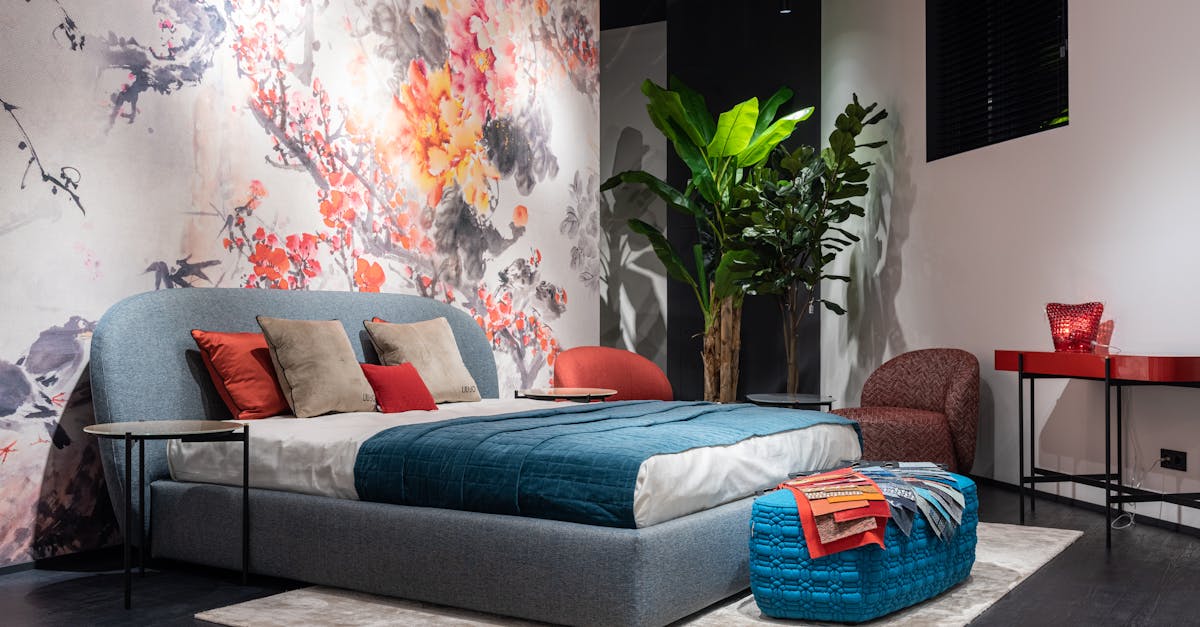Eco-Chic: Elevating Your Bedroom Space Sustainably

As sustainability continues to take center stage in our daily choices, it’s no surprise that individuals are seeking ways to integrate eco-friendly practices into every aspect of their lives, including their living spaces. One area that holds immense potential for sustainable transformation is the bedroom. The essence of ‘Green Bedroom Ideas: Transforming Your Space for Sustainable Living’ is to provide a comprehensive guide on how to merge sustainability seamlessly into bedroom design, making it a serene and environmentally conscious sanctuary. This article delves into a variety of aspects, from selecting sustainable materials like natural fibers and recycled furniture to implementing energy-efficient lighting and promoting indoor air quality through greenery. By embracing a neutral tone, the aim is to present informative content that showcases the benefits of a green bedroom without being overly persuasive, allowing the reader to make their own informed decisions for a more sustainable lifestyle.
1. Introduction to Green Bedroom Ideas
Thank you for reading this post, don't forget to subscribe!
Considering the increasing emphasis on sustainable practices, individuals are recognizing the significance of integrating eco-friendly concepts into their living spaces. This awareness has prompted a notable shift towards sustainable interior design, with bedrooms emerging as a key area for implementing these principles. The introduction to green bedroom ideas serves as an informative gateway into comprehending the crucial relationship between sustainable living and bedroom design. By exploring this relationship, individuals can gain a deeper understanding of how their personal spaces can embody eco-conscious choices without compromising style or comfort. This discussion sets the stage for a thorough exploration of eco-friendly materials, energy-efficient solutions, indoor air quality enhancements, and decor choices to curate a green and sustainable bedroom.
Sustainability isn’t just a buzzword; it’s a mindset that is steadily influencing our everyday decisions, and the bedroom is no exception. From the utilization of sustainable materials to the integration of energy-efficient lighting and appliances, the journey to a greener bedroom is multifaceted. This deliberate approach not only enhances the visual appeal of the space but also serves as a reflection of responsible consumer choices. By understanding the importance of sustainable living and how it seamlessly integrates into bedroom design, individuals can embark on a journey toward a more environmentally conscious lifestyle within the comforts of their home.
2. Choosing Sustainable Materials

In the pursuit of sustainable living, the selection of eco-friendly materials plays a pivotal role in shaping a green bedroom that harmonizes with an individual’s sustainable lifestyle. Natural fibers and textiles form the cornerstone of sustainable material choices, offering not only a reduced environmental footprint but also a heightened sense of comfort. Organic cotton, linen, and hemp are leading the charge in promoting sustainability within bedroom spaces, boasting qualities that prioritize both the well-being of the environment and the individual. These materials not only showcase an eco-conscious mindset but also contribute to a bedroom environment that values purity and natural aesthetics. Additionally, recycled and upcycled furniture offer an innovative approach to sustainable material selection, allowing individuals to infuse their bedrooms with character, all while minimizing their environmental impact through the repurposing of existing resources.
The process of choosing sustainable materials for a green bedroom encompasses a thoughtful consideration of the environmental impact of each element. By integrating natural fibers and textiles, individuals can enjoy the benefits of sustainability without compromising on quality or style. Furthermore, embracing recycled and upcycled furniture presents an opportunity to imbue the bedroom with unique, eco-friendly pieces that reflect a commitment to sustainable living. This conscious selection of materials not only shapes an aesthetically pleasing interior but also signifies a dedication to responsible consumption and environmental preservation.
Natural Fibers and Textiles
Natural fibers and textiles, including organic cotton, linen, and hemp, are increasingly heralded for their remarkable contributions to sustainability and comfort within bedroom spaces. Organic cotton stands out as a beacon of sustainable material, cultivated without the use of harmful chemicals or pesticides, thereby reducing environmental impact while offering a soft and breathable fabric for bedding and textiles. Similarly, linen, crafted from the flax plant, offers exceptional durability and breathability, promoting sustainability through its minimal water and pesticide requirements during cultivation. The versatility of hemp, known for its eco-friendly cultivation process and robust natural fibers, further reinforces the appeal of sustainable textiles, particularly in the creation of bedding, drapery, and upholstery within the bedroom. Embracing these natural fibers not only elevates the sustainable ethos of a bedroom but also contributes to creating a serene and comfortable environment that aligns seamlessly with a sustainable lifestyle.
The benefits of natural fibers such as organic cotton, linen, and hemp extend beyond their environmental advantages, resonating deeply with individuals seeking to cultivate a sustainable and tranquil bedroom space. Organic cotton, revered for its non-toxic production process, ensures that the materials in the bedroom are not just visually appealing but also devoid of harmful chemicals and pesticides, promoting a healthier indoor environment. Linen, prized for its ability to regulate body temperature and absorb moisture, fosters an environment of comfort and well-being, making it an ideal choice for bedding, upholstery, and drapery. Similarly, hemp’s strong and durable fibers exude sustainability, offering longevity and resilience while reducing the need for synthetic and environmentally detrimental materials in the bedroom setting.
Recycled and Upcycled Furniture
In the pursuit of sustainable interior design, integrating recycled and upcycled furniture stands as a key strategy to reduce environmental impact while adding character and individuality to a bedroom’s aesthetic. Recycled furniture offers a second life to materials that might otherwise contribute to landfill waste, thereby diminishing the carbon footprint associated with the production of new furniture. Embracing recycled pieces also fosters a sense of history and uniqueness within the bedroom, as each item carries its own story, contributing to a personalized and eco-conscious decor. Upcycled furniture, on the other hand, represents a creative and inventive approach to sustainability, repurposing existing items to create new and innovative furnishings. This process not only minimizes waste but also infuses the bedroom with distinctive, one-of-a-kind pieces that reflect a commitment to environmental responsibility and thoughtful design.
The inclusion of recycled and upcycled furniture in a bedroom setting offers a compelling opportunity to showcase style, sustainability, and individuality. By sourcing furniture made from reclaimed materials, individuals can curate a space that not only reduces environmental impact but also champions the beauty of sustainable design. This approach not only resonates with environmentally conscious consumers but also aligns seamlessly with a growing movement towards responsible and mindful consumption. Upcycled furniture, characterized by its inventive transformation of existing pieces, instills a sense of creativity and originality, further enhancing the allure of sustainable interior design within the bedroom.
3. Energy-Efficient Lighting and Appliances
Efforts to minimize electricity consumption while maintaining style and functionality find a natural fit in the integration of energy-efficient lighting and appliances within bedroom spaces. LED lighting serves as a prime example, offering a balance between lighting quality and energy efficiency. These lighting solutions not only reduce electricity consumption but also boast an extended lifespan, diminishing the frequency of replacements and contributing to a more sustainable bedroom environment. Similarly, the selection of energy-efficient appliances plays a vital role in conserving energy. From smart thermostats to energy-efficient air conditioning units and appliances with high Energy Star ratings, the options for reducing electricity consumption within the bedroom are diverse and contribute significantly to sustainable living without sacrificing modern comfort and convenience.
Integrating energy-efficient lighting and appliances aligns seamlessly with sustainable living while enhancing the functionality and ambiance of a bedroom. LED lighting, recognized for its low energy consumption and minimal heat emission, not only reduces electricity use but also enhances the visual appeal of the bedroom through customizable lighting options. Furthermore, the integration of energy-efficient appliances ensures that modern comforts are met with environmentally responsible choices. This approach not only addresses sustainability within the home but also reflects an understanding of the importance of energy conservation and responsible energy use, achieving an optimal balance between a comfortable lifestyle and environmental mindfulness.
4. Indoor Air Quality and Greenery

The strategic incorporation of greenery and eco-friendly air purifying solutions within bedroom spaces plays a pivotal role in enhancing indoor air quality while fostering a serene and tranquil atmosphere. Indoor plants offer a natural and captivating means of improving air quality, as they absorb pollutants and release oxygen, thereby contributing to a healthier environment. Not only do plants enhance the visual appeal of the bedroom, but they also promote a sense of well-being and connection to nature. Additionally, eco-friendly air purifying solutions such as activated charcoal and salt lamps complement the presence of greenery by further purifying the air, removing impurities, and creating a calming ambiance. These solutions, combined with strategic plant placement, offer a transformative way to promote a balanced and sustainable indoor environment that nurtures both physical and emotional well-being.
Enhancing indoor air quality through strategic greenery placement presents an opportunity to curate a bedroom space that is not only visually appealing but also conducive to well-being. Indoor plants act as natural air purifiers, removing harmful toxins from the air while infusing the bedroom with a refreshing and tranquil atmosphere. Moreover, the integration of eco-friendly air purifying solutions augments the purifying properties of plants, creating a harmonious and sustainable approach to indoor air quality. This deliberate incorporation of greenery and eco-friendly air purifying solutions aligns seamlessly with the growing emphasis on holistic well-being, interior aesthetics, and sustainable living practices.
Benefits of Indoor Plants
Indoor plants offer a multitude of benefits that extend beyond their visual appeal, profoundly impacting air quality, mental well-being, and overall aesthetics within interior spaces. Plants play a crucial role in enhancing indoor air quality by absorbing carbon dioxide and various air pollutants while releasing oxygen, thereby fostering a healthier environment. Beyond their air-purifying capabilities, indoor plants contribute to a sense of well-being, reducing stress and improving mood among individuals. Studies have shown that the presence of greenery within indoor spaces has a calming effect, promoting relaxation and mental clarity. Moreover, the introduction of indoor plants carries aesthetic advantages, adding a touch of natural beauty and vibrancy to interior spaces, ultimately elevating the overall visual appeal and ambiance of a room.
The positive impacts of indoor plants within interior spaces are truly multi-faceted, showcasing their significance as more than just decorative elements. Their ability to purify indoor air promotes a healthier living environment by reducing the presence of harmful pollutants, enhancing respiratory health, and fostering a sense of vitality. Additionally, the psychological benefits of indoor plants cannot be understated, as their presence contributes to reduced stress levels, improved concentration, and an overall sense of well-being. In terms of aesthetics, indoor plants soften interior spaces, introducing organic elements that complement various design styles, making indoor areas feel more inviting and connected to nature.
Natural Air Purifiers
The realm of natural air purifiers encompasses a diverse range of sustainable options, from activated charcoal to salt lamps, each offering unique benefits in fostering cleaner indoor air quality. Activated charcoal serves as a prominent natural air purifier, acclaimed for its exceptional ability to absorb and trap impurities and odors from the air. Its porous structure enables it to capture and neutralize contaminants, making it an effective and sustainable option for improving indoor air quality. Similarly, salt lamps, crafted from Himalayan salt crystals, are revered for their air-purifying properties through the release of negative ions, which purportedly counteract the presence of airborne pollutants and allergens. These natural air purifying options not only contribute to cleaner air but also add a touch of organic elegance to interior spaces, complementing a sustainable and well-balanced living environment.
Natural air purifiers offer a holistic approach to enhancing indoor air quality while embracing sustainability. Activated charcoal, with its absorptive properties, provides an effective means of reducing toxins and odors, ensuring a fresher and cleaner indoor environment. Moreover, salt lamps, with their gentle light and purported negative ion release, not only contribute to air purification but also add a soothing and ambient glow to interior spaces. The inclusion of these natural air purifying options underscores a commitment to sustainable and health-conscious living, providing a balanced approach to cultivating a harmonious indoor environment.
5. Promoting Minimalism and Upcycling
The integration of minimalism and upcycling as design principles within the bedroom serves as an influential strategy in reducing waste and enhancing the sustainable allure of interior spaces. Embracing minimalism entails a deliberate focus on simplicity and functionality, encouraging the prioritization of essential items while minimizing excess. This approach not only reduces clutter but also reinforces a mindset of conscious consumption. Upcycling, on the other hand, champions the creative reutilization of materials, repurposing existing items to breathe new life into them. By upcycling furniture and decor, individuals can contribute to waste reduction and environmental preservation, fostering a sense of ingenuity and resourcefulness within their living spaces. The synergistic fusion of minimalism and upcycling instills a refined and eco-conscious aesthetic within the bedroom, exemplifying a dedication to sustainability and thoughtful design.
Promoting minimalism and upcycling presents an opportunity to cultivate a bedroom environment that celebrates both aesthetic refinement and sustainability. Minimalism encourages a streamlined and uncluttered space, allowing for heightened appreciation of meaningful possessions and essential functionality. Concurrently, upcycling accentuates the value of resourcefulness and environmental responsibility, breathing new life into discarded items while diminishing the demand for new raw materials. This approach cultivates a bedroom environment characterized by purposeful design, conscious material choices, and a reduced ecological footprint, ultimately advancing the principles of sustainable living within interior spaces.
6. Eco-Friendly Decor and Accessories
The integration of eco-friendly decor and accessories within a green bedroom not only infuses the space with personalized touches but also contributes to a commitment to sustainable and environmentally responsible living. The conscious selection of decor and accessories allows individuals to express their unique style while minimizing their ecological footprint. From ethically sourced and artisan-crafted decor to organic bedding, the focus on eco-friendly elements exemplifies a dedication to sustainable living without compromising style or quality. Additionally, the inclusion of environmentally responsible decor and accessories promotes a connection to nature within the bedroom, fostering a sense of tranquility and harmony while reflecting a mindful approach to interior design that resonates with an eco-conscious lifestyle.
Incorporating eco-friendly decor and accessories within the green bedroom embodies a harmonious blend of personal expression and sustainable living. Ethically sourced decor items and artisan-crafted accessories not only showcase individual style but also promote responsible consumption and fair trade practices. Organic bedding and textiles further enhance the eco-friendly appeal of the bedroom, offering natural comfort and purity while supporting sustainable agricultural practices. This deliberate selection of decor and accessories not only elevates the aesthetic appeal of the bedroom but also underscores the holistic commitment to environmental consciousness and the incorporation of eco-friendly values within interior spaces.
How can I incorporate sustainable materials into my bedroom design?
You can integrate sustainable materials by opting for natural fiber textiles like organic cotton, linen, and hemp for bedding and upholstery. Additionally, consider using recycled or upcycled furniture to reduce environmental impact while adding character to your bedroom decor.
What are some effective eco-friendly air purifying options for improving indoor air quality?
Natural air purifiers such as activated charcoal and salt lamps offer sustainable ways to purify indoor air. Activated charcoal helps absorb impurities and odors, while salt lamps release negative ions to counteract airborne pollutants, both contributing to cleaner indoor air.
How can minimalism and upcycling benefit a sustainable bedroom design?
Embracing minimalism and upcycling supports waste reduction and elevates the sustainable appeal of the bedroom. These principles promote conscious consumption, reduce clutter, and encourage the creative reutilization of materials, contributing to a refined, eco-conscious aesthetic.
Why are indoor plants beneficial for a green bedroom?
Indoor plants not only enhance the visual appeal of a green bedroom but also improve air quality by absorbing pollutants and releasing oxygen. Additionally, they contribute to better mental well-being, reducing stress and enhancing the overall aesthetics of the bedroom.
What role do energy-efficient appliances play in creating a sustainable bedroom?
Energy-efficient appliances help minimize electricity consumption without compromising style and functionality, aligning with sustainable living. They contribute to reduced energy use, offering modern comforts while reflecting an understanding of the importance of energy conservation.




